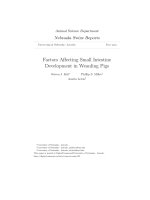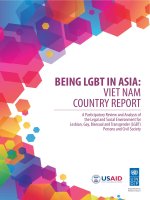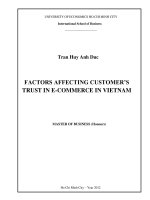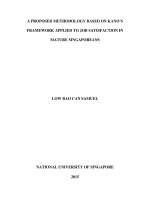Factors affecting overall job satisfaction in meinhardt viet nam LTD
Bạn đang xem bản rút gọn của tài liệu. Xem và tải ngay bản đầy đủ của tài liệu tại đây (776.99 KB, 53 trang )
MASTER OF BUSINESS ADMINISTRATION
INTERNATIONAL PROGRAM
BUSINESS RESEARCH PROJECT
(BMBR5103)
FACTORS AFFECTING OVERALL JOB SATISFACTON
IN MEINHARDT VIET NAM LTD.
STUDENT’S FULL NAME
:
PHAN MINH TRI
STUDENT ID
:
CGS000016265
COURSE
:
MBAOUM0514 – K14C
ADVISOR
:
DR. KHAI NGUYEN
Ho Chi Minh City, August 2015
Advisor’s Assessment
---------------------------------------------------------------------------------------------------------------------------------------------------------------------------------------------------------------------------------------------------------------------------------------------------------------------------------------------------------------------------------------------------------------------------------------------------------------------------------------------------------------------------------------------------------------------------------------------------------------------------------------------------------------------------------------------------------------------------------------------------------------------------------------------------------------------------------------------------------------------------------------------------------------------------------------------------------------------------------------------------------------------------------------------------------------------------------------------------------------------------------------------------------------------------------------------------------------------------------------------------------------------------------------------------------------------------------------------------------------------------------------------------------------------------------------------------------------------------------------------------------------------------------------------------------------------------------------------------------------------------------
Advisor’s signature
Page 1 of 52
ACKNOWLEDGEMENTS
I would like to express my gratitude to my supervisor Dr. Khai Nguyen for his dedicated
teaching and advising during this wonderful study time at Hutech University, and the library
staffs of Hutech for providing the support and information I needed.
I would like to thank all employees and my partners at Meinhardt VN Ltd. for providing me with
all the attention and information I needed for this study.
I would also like to thank my classmates who studied along with me and helped me in one way
or the other.
Page 2 of 52
Table of Contents
ABSTRACT ................................................................................................................................... 6
CHAPTER I. INTRODUCTION ................................................................................................ 7
1. 1 Company Description .......................................................................................................... 7
1.2 Organization structure........................................................................................................... 7
1.3 Company Services ................................................................................................................ 8
1.4 Business Sector ................................................................................................................... 10
1.5 Company problem ............................................................................................................... 14
1.6 Purpose of study.................................................................................................................. 15
CHAPTER II. LITERATURE REVIEW ................................................................................. 16
2.1 Goal and Process clarity and overall job satisfaction ......................................................... 16
2.2 Procedural Fairness ............................................................................................................. 18
2.3 Fairness in skill-based pay .................................................................................................. 20
2.4 Perceived Person-Organization Fit ..................................................................................... 21
2.5 Overall Job Satisfaction ...................................................................................................... 23
CHAPTER III. HYPOTHESIS MODEL & RESEARCH METHODOLOGY ................... 26
3.1 Hypothesis model................................................................................................................ 26
3.2 Research Methodology ....................................................................................................... 28
3.2.1 Data collection ............................................................................................................. 28
Page 3 of 52
3.2.2 Measurement of constructs .......................................................................................... 29
CHAPTER IV. DATA ANALYSIS AND HYPOTHESIS TESTING RESULT .................. 34
4.1 Reliability Test .................................................................................................................... 34
4.2 Descriptive statistic ............................................................................................................. 35
4.3 Correlation statistic ............................................................................................................. 35
4.4 Overall Hypothesis Testing Result ..................................................................................... 37
4.4.1 Hypothesis 1 result ....................................................................................................... 38
4.4.2 Hypothesis 2 result ....................................................................................................... 38
4.4.3 Hypothesis 3 result ....................................................................................................... 38
4.4.4 Hypothesis 4 result ....................................................................................................... 38
CHAPTER V. DISCUSSION AND RECOMMENDATION ................................................. 39
5.1 Discussion ........................................................................................................................... 39
5.2 Limitation ............................................................................................................................ 40
REFERENCES ............................................................................................................................ 42
APPENDIX: RESEARCH QUESTIONAIRES ...................................................................... 47
Page 4 of 52
LIST OF FIGURES
Fig 1. Meinhardt VN’s organization chart .............................................................................. 8
Fig 2. Hypothesis model ....................................................................................................... 26
LIST OF TABLES
Table 1. Measure of goal and process clarity ....................................................................... 30
Table 2. Measure of procedural fairness ............................................................................... 31
Table 3. Measure of fairness in skill-based pay.................................................................... 31
Table 4. Measure of perceived person-organization fit ........................................................ 32
Table 5. Measure of overall job satisfaction ......................................................................... 33
Table 6. Cronbach’s alpha testing values ............................................................................. 35
Table 7. Descriptive statistic results ..................................................................................... 35
Table 8. Correlation statistic ................................................................................................. 36
Table 9. Model Summary ..................................................................................................... 37
Table 10. ANOVA results..................................................................................................... 37
Table 11. Coefficients results ............................................................................................... 37
Page 5 of 52
ABSTRACT
Real estate industry in Viet Nam is growing back after falling down due to the economic crisis.
Construction companies are also growing back following the industry. In Viet Nam, we have
several famous international companies participating in construction service, and Meinhardt VN
Ltd. is one of those. The company provides services of construction consultancy such as project
management, project supervision, project bidding etc. The company business was very
successful from 2000 to 2010, but has been slowing down lately even though the real estate is
growing back.
This study examines factors affecting the employee’s overall job satisfaction at Meinhardt VN
and its relationship with overall job satisfaction. Four factors affecting are goal and process
clarity, procedural fairness, fairness in skill- based pay and perceive person – organization fit.
Through this study, it is tested and resulted that there is a positive relationship between goal and
process clarity, procedural fairness, fairness in skill- based pay and perceive person –
organization fit and overall job satisfaction in Meinhardt Viet Nam Ltd.
Key words: Goal and process clarity, procedural fairness, fairness in skill-based pay, perceive
person-organization fit, overall job satisfaction.
Page 6 of 52
CHAPTER I. INTRODUCTION
1. 1 Company Description
Meinhardt Group commenced operation in Australia in 1955, in Asia in 1973 and now employs
in excess of 3,500 permanent staff. The Group currently operates in 30 countries worldwide and
maintains permanent offices in USA, UK, UAE, India and Pakistan and throughout the Asia
Pacific regions. Ranked among the largest independent engineering consulting firms globally by
revenue, Meinhardt Group, with over 42 offices worldwide.
In Viet Nam, Meinhardt Viet Nam Ltd. (Meinhardt VN) was established in Ho Chi Minh City in
1995. The company has been granted a full license of engineering consultancy under 100%
Foreign Owned Company status and has been admitted as a member of Vietnam Engineering
Consultant Association (VECAS). Representative offices are established in Hanoi and Da Nang
to execute projects in the north of the country.
Through its close links with the other offices of the Group, the firm is able to obtain external
support and particular specialist expertise when required, so as to combine the Group global
presence and knowledge base with local experience.
1.2 Organization structure
The company has currently over 300 full time employees with a variety of expertise and a strong
combination of international staff, Vietnamese with overseas qualifications and experience, and
well qualified Vietnamese nationals. This allows the company to provide engineering services
that meet either Vietnamese or International Standards.
Page 7 of 52
Although the company is part of Meinhardt Group, however, the general director can decide all
the decisions by himself, meaning the general director has full power to ma
make
ke decisions. The
company structure consists of departments with its own directors. Department directors
d
are
directed by a specific deputy general director of the company.
Fig 1. Meinhardt VN’s organization chart
1.3 Company Services
Meinhardt VN Ltd. is fully licensed with variety ranges of consultancy services. Some main
services of the company are:
Architectural design
-
Concept Design: Sketches/ drawings with different options for the
building layout and general perspectives.
-
Basic Design: Provide general detail after completion of concept
design
-
Detail Design and Documentation: Complete set of architectural
Page 8 of 52
drawings and specifications suitable for construction.
Civil & Structural design
-
Concept Design: Concept on structural components, design parameters
and design standard report.
-
Detail Design: Develop detail civil, structural and foundation design,
calculations, drawings and specifications.
Mechanical & Electrical
- Water supply & storage and distribution system.
design
- Power supply & distribution and lighting system.
- Telecommunication system.
- Ventilation and air conditioning system.
- Fire fighting and protection system.
Project Management
-
Co-ordinate designers.
-
Arrange
Government
approvals
and
liaise
with
government
authorities.
Construction Supervision
-
Construction management and site supervision.
-
Examine and supervise quality of construction materials and
equipment used for the project.
-
Check construction methods of construction contractor.
-
Regularly and systematically supervise construction procedures of the
contractor on the site.
-
Organize the acceptance of the project.
-
Holding meetings, cooperate with other relating parties to settle all
misgivings, matters arising during the construction of the project.
Cost Management (QS)
- Preliminary cost estimates.
Page 9 of 52
- Development budgeting.
- Detailed construction cost estimates.
- Quantity surveying services prior to and during construction.
Tendering
consultancy
services
- Tender management.
- Pre-Qualification.
- Package procurement strategy.
- Tendering.
- Evaluation and negotiation.
1.4 Business Sector
There is a wide range of construction sector such as aviation construction, education
construction…For Meinhardt VT Ltd., the company has provided above mentioned services to
the following construction sectors:
a. Infrastructure sector
Provision of infrastructure is a core activity in development. The provision of proper utility
services in water, sanitation, waste disposal, electricity, gas and others, together with
transportation is a long-term. The company has been responsible for some recent key
developments in local infrastructure in Vietnam such as:
Ben Thanh Central Station (Contract Package 1-A) under Ho Chi Minh City Urban
Railway Construction Project Line 1: The Ben Thanh Station is a fully integrated public
transport interchange linking 4 lines of MRT, which are line 1, 2, 3a and 4 and an
underground bus station. Meinhardt VN Ltd. signs the sub-contract with the Association
to provide M&E design service for the project.
Client:
Ho Chi Minh City Urban Railway PMU
Page 10 of 52
Completion year:
2015
Saigon International Terminal Project: Provide design services and construction audit for
a container port including a wharf of 730m long and a container yard with an area of
33,700m2 together with all ancillary buildings.
Project Cost:
USD95 million
Year of completion: 2010
Phu My Bridge Extension Road Project: Provide project management and construction
supervision for three traffic projects invested under the form of BT contract (Building –
Transfer Contract) linking Districts 9, 2 and 7: The Eastern ring road stretching from Phu
My Bridge to Rach Chiec Bridge with length of 8.7km and width of 67m, the road
linking Phu My Bridge to traffic intersection South Saigon A with length of 1,655m
including an elevated road with length of 1,587m and width of 23.7m,and the South
Saigon A traffic intersection.
Client: Phu My Bridge B.O.T Joint Stock Company
Year of completion:
2009
Tan Son Nhat – Binh Loi Outer Ring Road Project: Provide Construction Supervision
and Project Management Services, the total length of project is 13.6 km.
Project Cost:
USD340 million
Year of completion: 2013
Page 11 of 52
b. Building sector
Critical to Meinhardt VN ’s approach and development in Viet Nam.The company provides the
full range of design services for buildings of all types and for all engineering disciplines. Typical
projects are:
Kumho Asiana Plaza, HCM: Provided preparation of tender documentation, tender
processing services and construction supervision for Kumho Asiana Plaza project located
at 39 Le Duan Street, District 1, Ho Chi Minh City. The project constructed on an area of
13,632m2 consists of a 21-storey hotel tower, a 32-storey apartment tower, a 21-storey
office tower and a 2-storey shopping center with underground car-park.
Client: Kumho Asiana Plaza Saigon Co. Ltd.
Construction cost:
US$200M
Completion year:
11/2009
“Saigon Paragon” Complex Building: provided project management – preconstruction,
cost estimation and tender documentation, review the design of M&E aspect and project
management and construction supervision for the USD 15M project.
Client: Kim Cuong Joint Stock Company
Completion year:
2008
EverRich Residential and Commercial Centre: Provided project management,
construction supervision, preparation of tender documents and contract for Everrich
Residential and Commercial Centre Project which comprises 2 towers with 20-storey in
height of each (excluding 2 basements and 5 podiums). The project is located at 940B Ba
Thang Hai Street, Ward 15, District 10, Ho Chi Minh City.
Page 12 of 52
Client:
Phat Dat Company
Completion year:
11/2009
c. Leisure and recreation sector
Including resorts and hotels across Viet Nam such as:
MGM Grand Ho Tram Tourist Complex Project: Provided general and detailed study
and design for this project. The Ho Tram Tourist Complex covers an area of 169 ha in
Xuyen Moc Commune of Ba Ria – Vung Tau Province. Construction of the Project 1
(phase 1 and 2) – including the two five-star hotels, Vietnam’s first Las Vegas-style
casinos and the specially designed Greg Norman golf completed by 2011. The entire 169
hectares of the Ho Tram Strip, featuring five Las Vegas-style integrated resorts, is
scheduled to be completely developed and operational within ten years. The total
investment capital of the project is worth of US$ 4.2 billions, the biggest FDI project of
its kind in Vietnam. Meinhardt VN.
Client: Asian Coast Development (Canada) Ltd.
Completion year:
(ACDL)
2010
Hilton Hotel and Resort, Cam Ranh Town, Khanh Hoa Province: Provided Civil and
Structural Design Services. The Hilton Hotel & Resort will include a hotel complex with
240 rooms and 45 hotel villas. The project also 190 residential villas and 3 apartment
blocks between 10 and 15 storey high set upon a 23 hectare site
Client: Mesa Group
Completion year:
2013
Page 13 of 52
d. Sport sector
Meinhardt VN won the First Prize in the contest of Planning, Descriptive Design and Tender
Document Preparation consultancy services for the Olympic Village in Jaber AL-Ahmed
Housing City, Kuwait selected by the Public Authority for Housing Welfare, State of Kuwait in
2012.
Olympic Village Project-Kuwait: The project site covers 23.6ha and has a mix of
sporting, residential and international facilities to enable the holding of International
sporting competitions over 27 sports. The main buildings with Gross Floor Area of
approximately 250,000 sqm and external landscaped and civil works of 117,000 sqm.
Meinhardt VN is appointed to provide Project Design Management as well as complete
Architectural and Engineering Design Consultancy Services.
Client: Public Authority for Housing Welfare
Construction cost:
approx. USD 1 billion
Award: 1st prize in the Design contest selected by the State of Kuwait, Public Authority
for Housing Welfare
Year of completion: 2014
1.5 Company problem
Employees of Meinhardt VN have recently had a tendency to drop out of the company, and the
quality of current employees is also reduced, i.e coming late, not fulfill duty…. Before this, the
employees had suffered salary deduction and late in monthly payment due to real estate crisis,
however, not much employees left the company during that time. When asked the reasons why
they left the company, the reasons are varied from aspects of salary, work environment, careers
Page 14 of 52
etc. especially, they mentioned how dissatisfaction about their current job/position within the
company.
As human resources is the main power of the company, keep losing employees and poorworkers harm significantly to the company business. Therefore there is a need to change this
situation.
1.6 Purpose of study
To resolve the above problem, the aim of this study is to examine factors affecting the
employee’s overall job satisfaction at Meinhardt VN, thus finding a way to increase their overall
job satisfaction. This study will focus on four factors and its relationship with the overall job
satisfaction in Meinhardt VN. These factors are:
- Goal and Process Clarity.
- Procedural Fairness.
- Fairness in Skill-based Pay.
- Perceived Person-Organization Fit.
Page 15 of 52
CHAPTER II. LITERATURE REVIEW
2.1 Goal and Process clarity and overall job satisfaction
Inspired by Sawyer (1992), this factor is belong to the role ambiguity such as clarity about a
job’s outcome goals and objectives, and certainty about a job’s process or how it should
performed respectively. In 1957, Smith conducted an experimental study with 140 college
students systematically varied the amount of role ambiguity and measured the effects on problem
solving. The study showed that when groups were asked to solve problems without clarification
of the role each member was to perform, their efficiency was significantly less than when the
roles were made clear; secondly, role ambiguity markedly reduced group satisfaction with the
experience; and thirdly, the hostility level was significantly higher for groups under conditions of
role ambiguity as compared to control groups.
Kahn et al (1964) expressed that to have an adequately perform employee’s role, they must know
what the expectations of the role set are (such as rights, duties, and responsibilities), what
activities will fulfill the role responsibilities, and what the consequences of role performance are
to themselves, others, and the organization. Conflict or uncertainty may occur when the three
types of information do not exist or when they are inadequately communicated. He suggested
that role ambiguity where lack of the adequately information available to a given job position
will result in coping behavior by the role incumbent, which may take the form of attempts to
solve the problem to avoid the stress, or to use defense mechanisms which change the reality of
the situation; thus, unclearly goal and process clarity could increase the probability that a person
will be dissatisfied with his role, will experience anxiety, will distort reality, and will thus
perform less effectively. A study showed that high degrees of role ambiguity resulted in
Page 16 of 52
increased tension, anxiety, fear and hostility, decreased job satisfaction, and loss of selfconfidence, often with lower productivity (Kahn et al, 1964).
Later on, Rizzo, House, and Lirtzman (1970) extended the definition of role ambiguity in terms
of the expected outcome or responses to one’s behavior and the existence or clarity of behavioral
requirements. These items reflect certainty about duties, authority, allocation of time, and
relationships with others. Another study of goal clarity by Gladstein (1984) demonstrated that the
clarity of team goals and individual members’ roles they communicate more effectively with
each other, which in turn serves to integrate each team member’s tasks with those performed by
others on the team. This mutual understanding facilitates the emergence of a shared vision of
their subgoals, team goals, and the processes needed for accomplishing tasks. Locke & Latham
(1990) also provided a goal-setting theory suggesting that clear goals will lead to improvement
of team performance due to their role in directing team members’ attention and encouraging
members to be persistent.
Lately, Stewart (2006) showed that a high level of goal clarity indicates that members as a whole
clearly understand their goals and the connection between their work and the objectives. As well
as a high level of process clarity implies that members clearly understand the procedures that
must be followed in order to achieve goals. Thus previous survey and experimental evidence
suggests that uncertainty of goal and process clarity would have undesirable impact for both
members and for organizational performance.
Page 17 of 52
2.2 Procedural Fairness
This factor is to assess employee perceptions about the fairness of the procedure used for making
pay-related decisions including pay determination, pay communication, performance appraisal
and appealing (Scarpello and Jones, 1996). In considering pay issues, there are commonly two
types of fairness that are distributive justice and procedural justice. While distributive justice
refers to the degree to which employees perceive their pay amount as fair, procedural justice is
concerned with the perceived fairness of the means or methods used to determine the amount of
pay. Greenberg & Folger (1983) defined distributive justice is concerned with the fairness of the
amount of resources distributed, procedural justice focuses on the fairness of the rules and
processes governing how such decisions are made. Folger and Konovsky (1992) defined that
distributive justice refers to the perceived fairness of the amounts of compensation employees
receive while procedural justice refers to the perceived fairness of the means used to determine
those amounts.
In the field of procedural justice, the most generally accepted and best-documented finding is
that allowing people an opportunity to voice their opinion about a decision enhances their
judgments of the fairness of the decision-making procedure. Hom and Griffeth’s (1995) study
showed that both perceived fairness of pay procedures and perceived fairness of pay amounts
were proposed as predictors of satisfaction with pay. Welbourne (1998) also concluded that both
distributive and procedural fairness affected satisfaction. Other research also supports a
relationship between procedural fairness and pay satisfaction.
A theory called fairness heuristic made a number of novel predictions about the psychology of
procedural justice and distributive justice. Fairness heuristic theory stated that in several
Page 18 of 52
situations fairness is a significant issue. More specifically, the theory demonstrated that people
especially need fairness judgments when they are concerned about potential problems associated
with social interdependence and socially based identity processes. An experimental example
developed by Lind, Kanfer and Early (1990) was that participants are requested to complete
tasks. Furthermore, it is communicated to subjects that the experimenter will decide on the
number of tasks they will have to complete. After a practice trial, the procedure that subjects
receive is manipulated: they are either allowed or not allowed an opportunity to voice their
opinion about the number of tasks to be completed. Findings of Lind, Kanfer and Early (1990)
showed a voice effect: subjects judged the procedure to be more fair when they were allowed
voice than when they were not allowed voice. Furthermore, the experimental manipulations
affected subjects’ task performance: subjects who were allowed voice completed more tasks than
subjects who were not allowed voice.
In terms of outcome favorability, high procedural fairness also increase the effect of outcome
favorability, relative to when procedural fairness is low (Gilliland, 1994; Ployhart, Ryan, &
Bennett, 1999; Schroth & Shah, 2000). There is more likely to be a positive relationship between
procedural fairness and self-esteem when outcomes are favorable rather than unfavorable.
Schroth & Shah (2000) proved that in the face of unfavorable outcomes, procedural fairness may
actually be negatively related to self-evaluations. Generally, many researchs (Folger, 1977;
Folger, Rosenfield, Grove, & Corkran, 1979; Walker, La- Tbur, Lind, & Thibaut, 1974) has
discovered that there is a positive relationship between procedural fairness and how people react
to the outcomes and satisfaction they may receive.
Page 19 of 52
2.3 Fairness in skill-based pay
This factor can be link to be a part of procedural fairness, that is involved in pay issues. Again,
one of the strongest determinants of employee attitudes, motivation and behaviors is
compensation (Gerhart & Milkovich, 1992). Fairness in skill-based pay reflects the fairness in a
skill-based pay program. Skill-based pay system employees for the range, depth, and types of
skills applied on jobs. Employee perceptions of the skill-based pay program are likely to be
influence by their perceptions that certification procedures are objective and cc tent across
people, times, and skills; include opportunities for employee ask questions about the decisions
made; and incorporate the use of accurate information (Lee, Law, and Bobko, 1998). By paying
for attributes (knowledge, skills, and abilities) of individuals, organizations hope to direct the
attention of their employees to developmental opportunities and to encourage skill-seeking
behavior.
Lawler, Mohrman, and Ledford (1992) reported that about 51 percent of large companies were
using skill- or knowledge-based pay programs in at least small portions of their organizations.
Most empirical evidence regarding the effects of skill-based pay comes from exploratory surveys
administered to human resource managers or personnel directors at facilities that use these pay
plans (Gupta, Jenkins, & Curington, 1986; Gupta, Jenkins, Curington, Clements, Doty,
Schweizer, & Teutsch, 1986; Jenkins, Ledford, Gupta, & Doty, 1992; Vaughn, Fottler, Bamberg,
& Blayney, 1991). They suggested some support for the declaration of increased workforce
flexibility, decreased labor cost, increased product quality, and increased productivity. A skillbased pay plan requires a fundamental departure from traditional job-based pay to a personbased approach that rewards employees for acquiring new skills (Gupta, Jenkins, & Curington,
1986; Jenkins, Ledford, Gupta, & Doty, 1992). Different from traditional job-based pay plans,
Page 20 of 52
skill-based pay are almost involved in a strategic plan for the organization (Lawler & Jenkins,
1992), implying greater returns on investment and greater accountability.
Gerald and Herbert (2011) suggested there are different forms that skill-based pay can take. One
form is the type of skills, knowledge or competencies that the system can compensate such as
depth (gaining greater expertise in existing skills); breadth (increasing one's range of skills); and
self-management (gaining skills that might previously have been reserved for higher levels in the
organizations, such as planning, training, budgeting, etc.). The second form focuses on whether
the reward offered is a bonus or base pay increase. Other different types of skill-based pay have
different configurations associated with different traditions, and goals and implementation
processes. Gerald and Herbert (2011) suggested that to decide whether skill-based pay is right
for one person or not, the system would requires careful analysis for any specific organization.
They also suggested that for employees to accept the pay system, they need to understand how
they can make more money under the system, and need a realistic idea of how long it will take to
advance. Not all employees will prefer any pay system design. Each pay system has winners and
losers, and losers tend to voice about pay. The key is making sure that the employees who are
happy with the system represent the ones that best fit SBP—that is, those with the skills and
orientation the organization needs to succeed—and that those who are unhappy are less valuable
to the organization.
2.4 Perceived Person-Organization Fit
Perceived person-organization (P-O) fit reflects the perception of employees over their fit with
an organization. Kristof (1996) defined P-O fit as “the compatibility between people and
organizations that occurs when at least one entity provides what the other needs, or they share
Page 21 of 52
similar fundamental characteristics or both”. People usually select environments that fulfill their
needs, a process resulting in person–environment fit (Diener, Larson, & Emmons, 1984; Pervin,
1989). Hence, the fit includes job seekers, employees and employers as well. For job seeker,
Tom (1971) expected that job seekers would prefer organizations that have the same
“personality” as they do. Cable & Judge (1994), Chatman (1989) study also showed that job
seekers prefer organizations where their personal characteristics are aligned with organizational
attribute. In fact, the proposition that individuals make job choice decisions based on personorganization fit. Empirical evidence supports the proposition that job seekers are affected by
congruence between their personalities and organizations’ attributes (Bretz, Ash, & Dreher,
1989; Burke & Deszca, 1982; Cable & Judge, 1994; Judge & Bretz, 1992; Turban & Keon,
1993). A theory by Schneider’s (1987) is attraction-selection-attrition (A-S-A) theory that
individuals are attracted to organizations that match their values and interests. Organizations, in
turn, tend to select candidates who are most similar to the organization. After entry into the
organization, individuals whose values are unequal with the organization tend to leave, either
willingly or unwillingly. With the attrition of these “different” individuals, those retained tend to
be similar to one another, which thus increases the homogeneity of the organization (Schneider,
2001). Theoretically, the relation between fit and attitudes is predicated on the reasoning that
when there is fit, the environment affords individuals the opportunity to fulfill their needs
(Pervin, 1992; Rounds, Dawis, & Lofquist, 1987; Schneider, Kristof-Brown, Goldstein, &
Smith, 1997). Need fulfillment results in favorable attitudes, such as job satisfaction and organizational commitment. In addition, social-psychological theories about similarity in attitudes
(e.g., Byrne, 1971; Newcomb, 1961) can also be used to explain why fit is posited to be related
to favorable attitudes. That is, people find it more desirable to interact with others who have
Page 22 of 52
similar psychological characteristics because the interaction verifies and reinforces their own
beliefs, expressed behaviors, and affect (Swann, 1987; Swann, Stein-Seroussi, & Giesler, 1992).
Thus, high levels of fit provide individuals opportunities to interact with similar others, and this,
in turn, results in favorable attitudes, such as job satisfaction and organizational commitment
For employers, personal-organization fit affect in the process of personnel selection (e.g.,
Adams, Elacqua, & Collarelli, 1994; Bowen, Ledford, & Nathan, 1991; cf. Rynes, Brown, &
Colbert, 2002) and the unique issues that surround the use of personal-organization fit in
employment decision making. The use of P-O fit for selection purposes appears to be on the
increase (Rynes et al., 2002). Adams et al. (1994) suggested that the focus on employment
interviews should shift from the prediction of performance approach to a focus that stresses the
interview’s usefulness for assessing P-O fit. In a similar vein, Judge, Higgins, and Cable (2000)
reviewed recent developments in the employment interview research that focus on the use of the
interview as a means of assessing P-O fit.
For employees in term of job satisfaction, there are many researches about relationship between
person-organization fit and job satisfaction, and mostly confirmed there is positive relationship
between these factors.
Increase person-organization (P-O) fit to increase job satisfaction
Kristof-Brown et al., 2005; Verquer et al., 2003). It is also true in the other hand when poor P-O
fit may lead to decreased job satisfaction (Wheeler et at (2005).
2.5 Overall Job Satisfaction
Numerous studies related to the overall job satisfaction. Job satisfaction can be described in
many terms such as degree of employee satisfaction with the work, co-workers, supervision,
Page 23 of 52
promotional opportunities, pay, progress, and the organization. It is a most frequently studied
variable in organizational behavior research, and also a central variable in both research and
theory of organizational phenomena ranging from job design to supervision (Spector, 1997).
The work of Maslow(1954) is seminal and suggested that human needs form a five-level
hierarchy ranging from physiological needs, safety, belongingness and love, esteem to selfactualization. Based on Maslow’s theory, job satisfaction has been approached by some
researchers from the perspective of need fulfillment (Kuhlen, 1963; Worf, 1970; Conrad et al.,
1985). However, this approach has become less popular with increasing emphasis on cognitive
processes rather than on underlying needs so that the attitudinal perspective has become
predominant in the study of job satisfaction (Spector, 1997).
In contrast to the traditional view, Herzberg and Mausner (1959) formulated the two-factor
theory of job satisfaction and postulated that satisfaction and dissatisfaction were two separate
and sometimes even unrelated phenomena. Fundamental factors which they called ‘motivators’
like nature and experience of doing work were found to be job ‘satisfiers’, including
achievement, recognition, work itself and responsibility. Extrinsic factors which they called
‘hygiene’ factors were found to be job ‘dissatisfiers’ which including company policy,
administration, supervision, salary, interpersonal relations and working conditions. Herzberg and
Mausner’s Motivation-Hygiene theory has dominated the study of the nature of job satisfaction,
and formed a basis for the development of job satisfaction assessment. So the causes of job
satisfaction are varied. An interesting experiment by Staw, Bell, and Clausen (1986) even
discovered a link between childhood personality and job satisfaction later in life, there has been
considerable interest in the relationship between individual nature and job satisfaction. There is
Page 24 of 52









